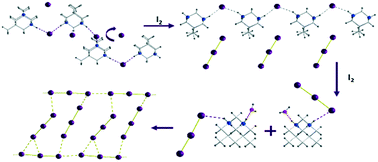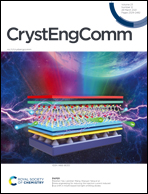Synthesis and supramolecular organization of the iodide and triiodides of a polycyclic adamantane-based diammonium cation: the effects of hydrogen bonds and weak I⋯I interactions†
Abstract
A careful selection of organic and inorganic components enables the production of unusual structure types with promising practical properties by facile syntheses. In this paper, we describe novel supramolecular architectures comprising organic adamantane-like divalent building blocks and iodide or polyiodide anions. Highly acidic conditions facilitated the formation of a doubly protonated organic ligand out of 5,7-dimethyl-1,3-diazaadamantane that generates three different crystal structures with inorganic counterions. In these structures, cationic substructures are constructed by transforming neutral organic ligands into [(C10N2H20)I]+ or [(C10N2H20)(H2O)]2+ cations, which crystallize with charge-compensating iodine-based anions of different complexities. All three crystal structures are characterized by various noncovalent forces, ranging from strong (N)H⋯I, (O)H⋯I, and (N)H⋯O hydrogen bonds to secondary and weak I⋯I interactions. Raman and diffuse reflectance spectroscopy as well as DFT calculations were employed to describe the electronic structures and optical properties of new supramolecular architectures, with particular attention to the role of non-covalent interactions.

- This article is part of the themed collection: Crystal Engineering Techniques


 Please wait while we load your content...
Please wait while we load your content...
